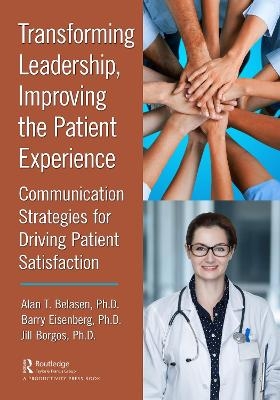
Transforming Leadership, Improving the Patient Experience
Productivity Press (Verlag)
978-1-032-55515-7 (ISBN)
Surprisingly, however, healthcare leaders tend to prioritize specific metrics to improve hospital performance and patient satisfaction even though patient experience and provider-patient communications are intertwined. Determining the most effective strategy for achieving higher levels of service quality and patient satisfaction can prove elusive for providers.
Consider the evidence: a survey in 2012 of more than 17,000 healthcare leaders in North America, for example, found that leaders’ perceptions did not always match the data, and many hospital leaders overestimated the performance of their hospitals. Over 75% of the hospital leaders reported "quality of care" was something their hospital did well, while their patients, on average, rated them lower on perceived service quality. Ten years later, in 2022, only a few providers integrated best practices to achieve high patient satisfaction which severely impacted CMS Hospital Star Rating. This has significant effects on profit margins since patients consider the star rating differentials in their choices of hospitals and are willing to pay upward of 17% extra for treatments in 5-star hospitals, a revenue generating source of income at times when hospitals have seen falling revenues (down 4.8%) and rising labor (up 37%) from pre-COVID-19 pandemic levels.
To reduce the gap between perception and reality, hospital leaders can consider the link between communication goals (e.g., responsiveness of hospital staff, pain management, communication about medicines) and outcomes (e.g., increased adherence and compliance, readmission, healthcare delivery costs, hospital overall ratings) as well as improve the patient experience.
When intentions and outcomes are aligned, they create a powerful medium by which healthcare leaders can evaluate the gaps that exist between patient care measures and best practices and mitigate organizational or technological factors relevant to improving the patient experience. When the alignment is optimal, care teams develop a better sense of shared purpose, become more committed and accountable, and work together to improve the patient experience. When accomplished, patients participate more fully and actively in the exchange and are discharged with an enhanced commitment to carry out care management requirements.
Key topics in this practical guide include provider-patient communications; demonstrating the value of patient-focused care; how physician and nurse executives use synergy as a strategy; engaging board members in promoting quality and safety goals and in developing hospital community partnerships; building bridges between physicians, administrators, trustees, and hospital staff; and developing a leadership pipeline.
Alan T. Belasen, Ph.D., has over 25 years of experience in professional, management, and leadership development. He led the design and implementation of the MBA programs in management, global leadership, and healthcare leadership at SUNY Empire State College. Dr. Belasen has published on topics such as executive education, hospital leadership, quality of care, crisis leadership, healthcare communication, and women’s leadership. Dr. Belasen has written numerous books including Resilience in Healthcare Leadership: Practical Strategies and Self-Assessment Tools for Identifying Strengths and Weaknesses (Routledge, 2022); Dyad Leadership and Clinical Integration: Driving Change, Aligning Strategies (HAP, 2019); and Women in Management: A Framework for Sustainable Work-life Integration (Routledge, 2017). He is the recipient of the International Accreditation Council for Business Education’s 2017 John L. Green Award for Excellence in Business Education, and the 2014-2015 SUNY Chancellor’s Award for Scholarship and Creative Activities. Barry Eisenberg, Ph.D. has forty years of experience in healthcare management, consulting, and higher education. He established and directed a management development program at Memorial-Sloan Kettering Cancer Center in New York, and later served as vice president of human resources and vice president of operations at Union Hospital in New Jersey. In addition to directing SUNY Empire State College’s MBA in Healthcare Leadership, Dr. Eisenberg consults with health care organizations on strategic planning, mergers and acquisitions, market expansion, and board of directors’ development. Dr. Eisenberg is co-author of Mastering Leadership: A Vital Resource for Healthcare Organizations (Jones & Bartlett Learning, 2015). He also maintains a blog which addresses health issues, among many others, with a wide distribution: https://barryeisenbergauthor.com/blog. Dr. Eisenberg serves on the boards of nonprofit organizations dedicated to expanding access to scholarship, social justice, and promoting arts education. Jill Borgos, Ph.D., M.S., R.N. is an assistant professor in SUNY Empire State College’s MBA in Healthcare Leadership program. She holds a Ph.D. from the University at Albany in Educational Policy & Leadership, a Master of Science degree from the University of Michigan Rackham Graduate School in Nursing Administration & Patient Care Services, and a Bachelor of Science degree in Nursing from Boston College. Dr. Borgos has 30 years of combined academic, clinical, and leadership experience in healthcare. She has previously held academic appointments in Nursing undergraduate and graduate Programs where she taught courses in Health Policy, Organizational Behavior, and Population Health. With an interest in education as a determinate of health outcomes globally, Borgos’ research areas focus on the internationalization of higher education. She has published and presents on cross-border medical and nursing education, organizational social network analysis, resource dependency across geopolitical borders, and distance learning. Borgos is the 2013 recipient of University at Albany’s Sanford H. Levin Fellowship for her work in educational leadership and a 2015 recipient of a Sigma Theta Tau International Recognition Award for Excellence in Nursing Research.
Chapter 1.Introduction - Bridging the Intention-Action Gap Chapter 2.Provider-Patient Communication - Evidence from the Field Chapter 3.The Critical Nature of the Nurse-Patient Relationship Chapter 4. Board Leadership and Stakeholder Engagement Chapter 5. Communicating Quality - Hospital Leadership and Performance Outcomes Chapter 6.Nursing Leadership and the Patient Experience Chapter 7.Engaging Hospital Boards in Patient Safety and Quality of Care Chapter 8.Shared Leadership and the Patient Experience Chapter 9.The Nurse Executive Professional Development Chapter 10.Conclusion - Leadership Practices to Improve the Patient Experience
| Erscheinungsdatum | 29.02.2024 |
|---|---|
| Zusatzinfo | 7 Tables, black and white; 6 Line drawings, black and white; 6 Illustrations, black and white |
| Verlagsort | London |
| Sprache | englisch |
| Maße | 178 x 254 mm |
| Gewicht | 449 g |
| Themenwelt | Sachbuch/Ratgeber ► Gesundheit / Leben / Psychologie |
| Medizin / Pharmazie ► Gesundheitswesen | |
| Medizin / Pharmazie ► Medizinische Fachgebiete ► Medizinethik | |
| Wirtschaft ► Betriebswirtschaft / Management ► Planung / Organisation | |
| Wirtschaft ► Betriebswirtschaft / Management ► Unternehmensführung / Management | |
| Wirtschaft ► Volkswirtschaftslehre | |
| ISBN-10 | 1-032-55515-7 / 1032555157 |
| ISBN-13 | 978-1-032-55515-7 / 9781032555157 |
| Zustand | Neuware |
| Informationen gemäß Produktsicherheitsverordnung (GPSR) | |
| Haben Sie eine Frage zum Produkt? |
aus dem Bereich


